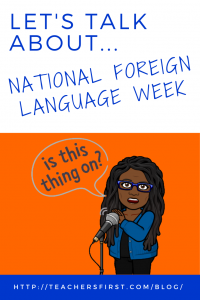If you talk to a man in a language he understands, that goes to his head. If you talk to him in his language, that goes to his heart.
—Nelson Mandela
The first whole week of March is National Foreign Language Week (NFLW). The purpose of the week and the various activities sponsored is to help make American students “aware of the vital necessity for foreign language study.” With only 20% of American students studying foreign languages in elementary schools and even less in college, our country has genuine reasons to be concerned.
The Case for Foreign Language Education
There are numerous reasons why our students should be studying foreign languages. Young Zachary Hines argues for foreign language education rooted in the need for Generation Z to be competent members of the global society. He tells us that Americans his age are already behind concerning understanding other cultures and their viewpoints as we can communicate with people all over the globe instantly, have a global economy, and possibilities international cultural exchange. Studying languages, according to Hines, helps people understand different cultural ideals, which in turn provides a new map for communication.
Journalist Gaston Dorren urges us to “grow up,” explaining that speaking multiple languages transforms us as human beings. He gives us several additional effects of speaking numerous languages. According to him, people who are fluent in multiple languages make more money. In addition, science has proven that speaking multiple languages makes your brain more neurologically flexible, actually delaying the onset of dementia. Dorren also believes that thinking in multiple languages can help you make decisions more rationally.
Citing health benefits like delaying the onset of dementia and increased executive function, award-winning educator Louka Parry says the question we should be asking isn’t “why learn another language.” Instead, the question we should answer is why we haven’t. Learning a new language helps us become life-wide and lifelong learners with better communication skills. Understanding how others communicate helps us connect with them as human beings and better understand their perspectives. Understanding their view is also necessary to compel someone to take action.
Dr. Juliana Mosley takes the case a step further for us with the concept of cultural humility. Learning the language and customs of another group of people says that you value what they bring to the table as complex multidimensional human beings. Understanding that culture heavily influences a person’s thoughts, beliefs, and choices, we need to reflect and self-evaluate when interacting with others. She explains that there is a time when being grounded in who you are, you can submit yourself to another culture’s ideals and viewpoints. Being able to bow to another person’s culture, persona, and position is a tangible demonstration of strength.
Activities for Foreign Language Week
The theme for NFLW this year is “Celebrate Humanity Through Language.” You could use many activities to celebrate what we as the human race have in common and at the same time pique interest in learning about others and their culture. However, as this post is already long enough, I’ll limit myself to four technology-integrated activities that you can use across grade levels.
Use a Photo – Use Phrase.it (reviewed here) to add speech bubbles to an image with some cute dialog. Then use Microsoft Translator (reviewed here) to translate the words into a target language. This quick and easy activity can adapt to any content area or grade level. For example, suppose your third graders are studying ancient civilizations. In that case, they can use a photo of something that our progenitors invented. High school chemistry students can use a picture of a scientist – like Marie Curie – making a discovery and explain what they found.
Practice Phrases – Use Synth (reviewed here) to practice and compare phrases in multiple languages. After setting up your conversation space, allow your students to translate or react to a phrase. Students who already speak a foreign language can respond in their preferred language. Others might need to use Microsoft Translate to participate. After everyone has contributed, spend some time comparing the different languages.
Create a Comic – Funny situations convey cheer regardless of their language. CANVA comic strips (reviewed here) allow the student a choice of ways to depict their story. Have your students create their comic and then translate captions as appropriate.
Virtual Handshake – A virtual handshake is a great way to introduce your class to another group that could be anywhere in the world. Use the Gridpals section of Flipgrid (reviewed here) to find an interested group of students.
Extend NFLW using these strategies or one of your own. Do you have a particular activity planned for this week? Let us know in the comments below.



Hello Ruth,
I loved reading this post and particularly liked the info on Gridpals! I had no idea this existed and I am going to see if I can find students interested in speaking with my Italian students. I wholeheartedly agree that we’re behind as a nation in learning foreign language compared to the rest of the world. Foreign language needs to become a priority to raise global citizens! Thanks for great ideas!
Angelina